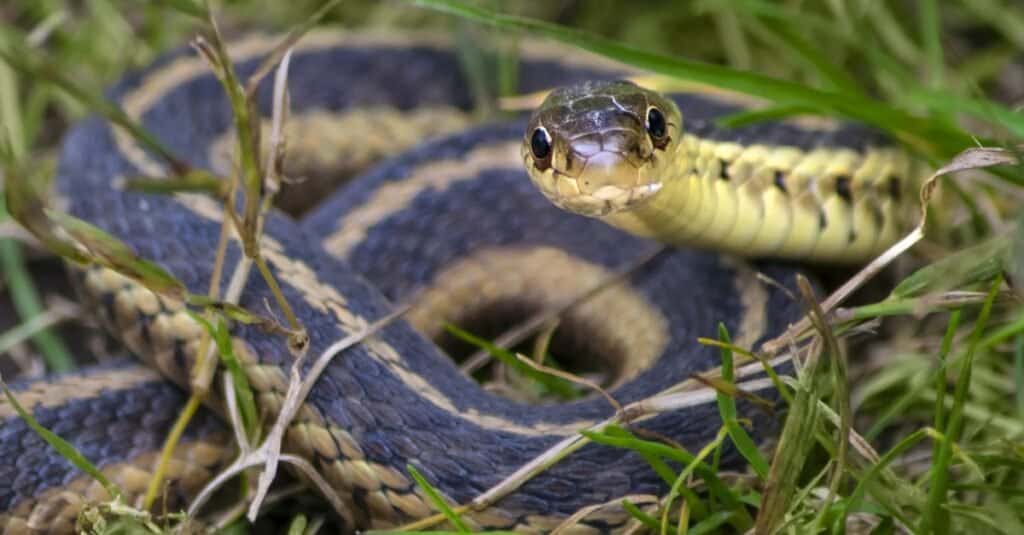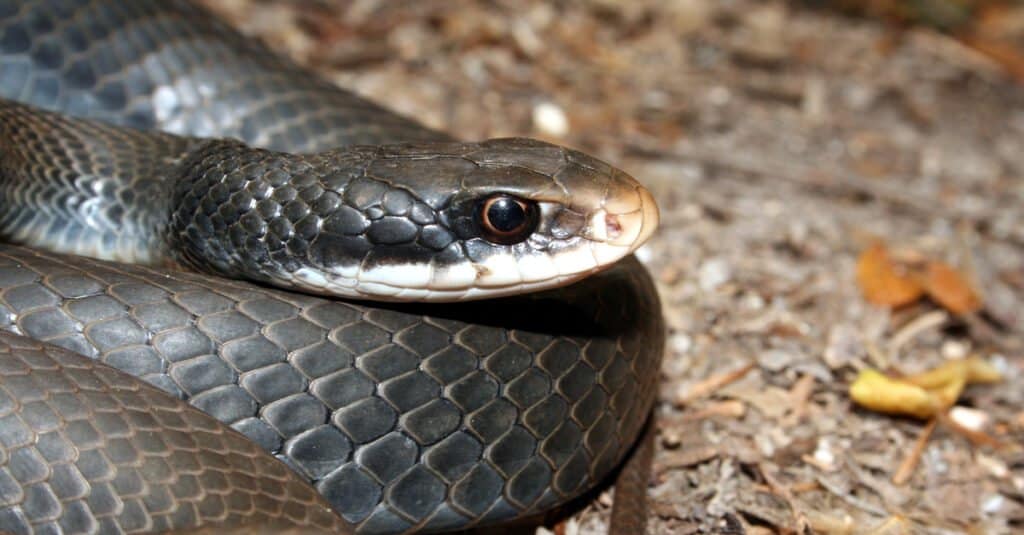Snakes are one of the most common features of living in North Carolina. Thankfully, most of the scaly visitors in the Tar Heel state are harmless and most often beautiful. Rat snakes are some of the most common snakes across the eastern United States and are present in almost every environment. Today, we will learn all about North Carolina’s rat snakes and how to identify them. Let’s get started!
What Are Rat Snakes?
Rat snakes are a varied group of snakes that belong to the Colubridae family, along with kingsnakes and indigo snakes. They are generally characterized as medium-sized constrictors that prey on rodents, giving them their name. Rat snakes are totally harmless to humans, and many of them are kept as pets, especially corn snakes.
There are three species of rat snake in North Carolina, all of which help humans by reducing mice and rat populations in all the environments they happen to live in. We will cover each snake and describe some of its essential identification features. Additionally, we will look at some other snakes in North Carolina that could potentially be confused for a rat snake.
A Complete List Of Rat Snakes In North Carolina
Eastern Ratsnake (Pantherophis alleghaniensis)

The eastern ratsnake is a long black snake found across nearly all of North Carolina.
©iStock.com/RCKeller
Identification: Eastern ratsnakes are characterized by their black body and white or cream belly. Their scales are weakly keeled, meaning they have a slight ridge to them. Most eastern ratsnakes have faint white tracing around their scales, helping them stand out individually. These are some of the longest snakes in the eastern United States, with adults growing up to six feet in length.
Eastern ratsnakes and black ratsnakes are nearly identical visibly and genetically to the point that many people consider the black ratsnake a subspecies.
Distribution: Eastern ratsnakes can be found across the entirety of North Carolina, but their range ends in the western Appalachian mountains.
Gray Ratsnake (Pantherophis spiloides)

Gray rat snakes are gray or black. Most of them have brown or black patterns on their back, but some are a uniform gray.
©dkHDvideo/Shutterstock.com
Identification: Gray ratsnakes are characterized by their gray or black body, white belly, and black or brown patterning across their back. Some variations of the snake are brown, and other variations have little to no saddle markings across their backs. Their scales are a bit rougher than other species of rat snake due to their stronger keels. Adults usually grow to 3-6 feet in length and are comparable in size to the eastern ratsnake.
Distribution: Gray ratsnakes can be found in the western ranges of the Appalachian mountains. They rarely venture into the piedmont regions of the state and are usually found west of Asheville.
Red Ratsnake / Corn Snake (Pantherophis guttatus)

Corn snakes are common pets that are native to North Carolina.
©Enrique Ramos/Shutterstock.com
Identification: Red ratsnakes are characterized by their bright orange or red bodies. They are incredibly vibrant snakes with orange or red saddle markings that are often ringed in black. Their bellies are white with black markings and usually have a checkerboard pattern. The checkerboard belly pattern resembles flint corn, giving them their name. Adults can reach lengths of 1.3-3 feet long.
Corn snakes are beautiful and docile snakes and have earned a spot as one of the most popular pet snakes in the United States. People have been breeding them for decades, and there are hundreds of corn snake morphs available online and in pet stores.
Distribution: Corn snakes are common across much of North Carolina. They are most often found in the southern third of the state and in the Outer Banks.
Possible Rat Snake Lookalikes In North Carolina
There are two species of snake that could potentially look like rat snakes in North Carolina. Neither of them is venomous and can be found in the same environments as rat snakes.
Garter Snake

Garter snakes have three stripes that travel the length of their bodies.
©K Quinn Ferris/Shutterstock.com
The eastern garter snake is commonly encountered across North Carolina. The best way to identify a garter snake is through its distinctive striping pattern running down its back. Garter snakes have three stripes, one on the spine and one on either side of their body. The center stripe is usually white or cream, while the other two are more yellowish. Some variations have a checkerboard pattern down their backs with a central stripe down their spines.
Garter snakes come in black, brown, and olive and are most often seen in backyards, meadows, and near water sources.
Black Racer

Black racers are long, thin snakes with a white chin and gray belly.
©Psychotic Nature/Shutterstock.com
Southern black racers are long, slender snakes found across all of North Carolina. They have a sleek black color and have white chins. Racers get their name for their speed as they are incredibly fast snakes. Their scales are smooth, not keeled, helping to distinguish them from rat snakes.
When black racers are young, they are usually gray or brown and have red or brown spots running down their back. As they age, the spots fade, turning a uniform black color.
Black racers are more aggressive than corn snakes, although equally harmless. If handled, they are known to strike, but these nonvenomous snakes can do little to harm an adult human.
Summary of 3 Rat Snakes in North Carolina:
| Name | Appearance | Length | Location |
|---|---|---|---|
| Eastern Ratsnake | Black body, white or cream belly | Up to 6 feet | Across North Carolina but range ends in western Appalachians |
| Gray Ratsnake | Gray or black body, white belly; brown or black pattern on back | 3-6 feet | Western Appalachians |
| Red Ratsnake/ Corn Snake | Bright orange or red body, white belly with black markings; orange or red saddle markings | 1.3-3 feet | Across North Carolina, mostly in southern third and Outer Banks |
The photo featured at the top of this post is © Mike Wilhelm/Shutterstock.com
Discover the "Monster" Snake 5X Bigger than an Anaconda
Every day A-Z Animals sends out some of the most incredible facts in the world from our free newsletter. Want to discover the 10 most beautiful snakes in the world, a "snake island" where you're never more than 3 feet from danger, or a "monster" snake 5X larger than an anaconda? Then sign up right now and you'll start receiving our daily newsletter absolutely free.
Thank you for reading! Have some feedback for us? Contact the AZ Animals editorial team.






